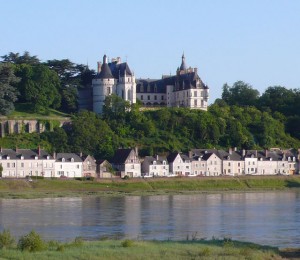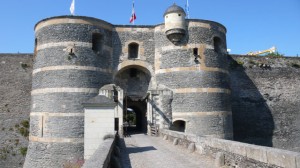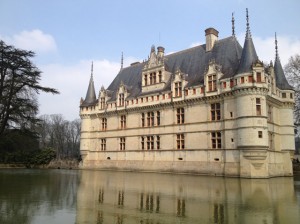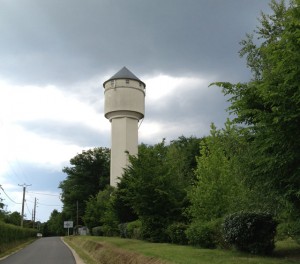When is a castle not a castle? When it’s a chateau.

The two words have the same Latin origin – castellum, meaning fortress. The transformation from ca to cha in French is very common : cat/chat, cauldron/chaudron, cart/charrette, etc. In château, the “s” has done its usual disappearing act and turned into a circumflex e.g. pasta/pâte, feast/fête, master/maître. Then the “l” has been vocalised which means that it has become a vowel, which is another typical change, witness by camel/chameau and cauldron/chaudron above.
What is generally called a castle in English is actually a château fort in French. Prime examples are Chinon and Angers. Fort means strong and is obviously at the origin of fort/fort and fortress/forteresse. We have our Anglosaxon word stronghold. Châteaux forts had moats/fosses, ramparts/ramparts, towers/tours and keeps/donjons.

A château does not have to be fortified, nor even be royal, so what can and cannot be described in French as a château is somewhat nebulous.
The châteaux in the Loire Valley, such as Chenonceau, Chaumont and Chambord, were never built to offer protection but they were mostly owned and built by royalty. Others, such as Azay le Rideau and Villandry, were often stately homes built by rich financiers and such like with all the trappings of a château. I guess they could roughly be described as pleasure castles.

The plural of château in French is châteaux, but in English you can choose between châteaux and chateaus and there’s no obligation to keep the circumflex or chapeau as it’s often called in French.
There are two other common uses of the word château. In the Bordeaux area (bordeaux wine is written with a small letter, by the way, in both French and English), all vineyards are châteaux whether big or small. The same does not apply to other wine-growing areas in France (but the small letter still applies – champagne from Champagne, burgundy/bourgogne from Burgundy/Bourgogne, chinon from Chinon).

Then there is the château d’eau which is a water tower and, to me, is the strangest use of the word. They certainly don’t look like castles. I have to be honest and say that I had never noticed any water towers in Australia but in France, you can’t miss them!
Last, by not least, we have the château de cartes which is our humble house of cards.




Your Friday’s posts are always interesting, taking me much further than High School French, which seems so basic compared to how you explain actual usage in France. Language grows and develops and the reasons for why e.g. a water tower is a chateau d’eau is lost in the mists of time. But when you think of it, we call it a “tower” which is what it resembles – a corner tower of a castle perhaps? Also we were pretty familiar with water towers as we travelled a fair amount up North with my grandparents during the school holidays and the sight of the water tower at Ingham or Innisfail for example was the sign we were almost there!!!
Innisfail’s tower has made it onto the heritage list.
http://www.qldheritage.org.au/state-heritage-listing-for-innisfail-water-tower.html
Thank you, Jane’s cousin. The one in Innisfail looks more like a lighthouse, doesn’t it? I had started to collect photos of water towers here then forgot about it. I’ve seen some very highly decorated ones. As you can guess from my Friday’s posts, I love etymology and the evolution of language. I also think it is very reflective of the culture of another country. I’d love to really speak a third language properly so I could make even more comparisons! Maybe one day I’ll brush up my Italian or Spanish enough.
Ha – I loved this little lesson in etymology! I have often wondered what, if any, is the difference. Fun post and great photos!
Thank you Breadispain! I enjoy writing them.